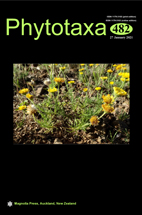Abstract
Eriobotrya shanense, a new species from the karst region of Shan State, eastern Myanmar, is described and illustrated. This evergreen tree is similar to the autumn and winter-flowering, large-leaved species E. malipoensis and E. japonica by having tomentose hairs on the abaxial leaf surface, but can be distinguished by its obovate, widely obelliptic or oval blade shape, leaf length-width ratio of 2:1 (vs. 3:1), and rounded or obtuse apex (vs. acute). The species also resembles less-known, undercollected Myanmar broad-leaved species E. wardii and E. platyphylla in leaf shape and length-width ratio, but can be easily differentiated by the presence of tomentose hairs on the leaves, and inflorescence. Phylogenetic analysis based on nrDNA ITS region supported its close affinity with E. malipoensis and E. japonica. Molecular data also generally grouped the 17 congeneric taxa accessions in congruence to their leaf morphology, with the entire Eriobotrya clade strongly supported to be monophyletic and separate from Rhaphiolepis.

